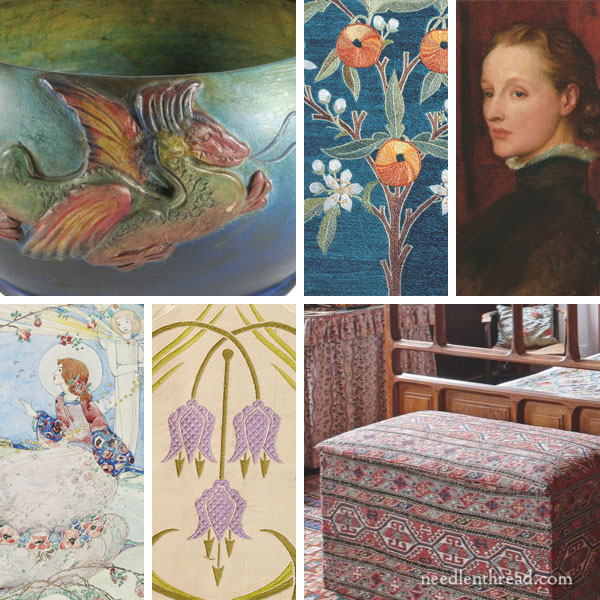I tend to be somewhat infatuated with the Arts & Crafts Movement. There’s much about it – historically, socially, and artistically – that I admire and that intrigues me.
The Arts & Crafts Movement was an era of development of the decorative arts, spanning about 1875 to about 1920, give or take some years.
As with any era or trend in the decorative arts, it’s hard to establish an exact beginning date and an exact ending date, because no trend in art is isolated from its preceding and subsequent trends. What came before influences the era; what comes after develops from the era or as a reaction to it. But roughly, that’s that time frame – 1875 to 1920, beginning in Britain and spreading throughout Europe and America.

You’ll find several well-known names associated with the Arts & Crafts Movement: William Morris, John Ruskin, Augustus Pugin – these three were perhaps the main movers and shakers behind the decorative trends that would expand and eventually encompass much of the globe.
But lately, as we’ve enjoyed a revival of interest in the Arts & Crafts Movement, many of the women involved in the movement have gained more and more of the spotlight.
For those who would like to learn more about these women and about the decorative arts they pursued to a high form of excellence, I thought you’d appreciate this article, “Discover the Forgotten Women of the Arts and Crafts Movement” on Home and Antiques. Grab a cuppa and enjoy reading it this weekend!
May Morris: Decorative Needlework
A belief in the power of beauty is a wholesome thing, and I make no apology for preaching it…
And while you’re at it, delve into the rabbit hole of May Morris’s book, Decorative Needlework, available on Internet Archive.
This is a very easy-to-read book that unfolds many principles of design and technique that governed needlework during the Arts and Crafts Movement. I think it’s worth reading!
Does everything Morris says apply necessarily today? No, not necessarily. But many of the principles are certainly worth at least considering in your own embroidery pursuits.
I hope you enjoy these two resources and that you can spend a little time exploring them!
Have a wonderful weekend!







Great post, Mary!
I also have an interest in this style, as well as the Art Deco, Art Nouveau and Prairie styles. I think they are very elegant and pretty. Would love a home designed/decorated in one of them. Right now I’m living in 1990s tract home beige. Bleah.
Carol
Thank you for sharing the article! I’m so thrilled it mentions Margaret McDonald Mackintosh, wife of Scottish designer Charles Rennie Mackintosh. Margaret was his partner in every sense, and her contributions to their work are all but forgotten.
Nicola Jarvis has done a lot of work influenced by the Arts and Crafts movement including a show in London several years ago featuring her work as well as that of May Morris. She also has several kits available at her website. Nicola is a graduate of the Royal school of Needlework and continues to work as a tutor there. She was on the team that made the lace for the Princess of Wales’ wedding dress!
Thanks for sharing this article; you’re singing my tune! Up until a few years ago, we lived in a 1907 Craftsman house with incredible oak woodwork. (It was fortuitous that the previous owners, ca. 1942-1993, were too unmotivated to remuddle anything but the kitchen.) We furnished it with Arts & Crafts era antiques, I bought every book I could find on the era, and I stitched pieces in that style. Some of the furnishings are still with us after downsizing to a 1930 vernacular farmhouse but they don’t come off quite the same in this setting.
If you’re a fan of PBS mystery/crime series, you may want to check out, if you haven’t already, “Vienna Blood,” set during the German Art Nouveau period. The visuals are stunning! The set designer must have had a blast.
May Morris’ book is both charming and practical. Thanks for the link! I hope you have a lovely weekend.
Oh Mary, thank you so much for these wonderful resources. I’ve discovered new artists which is always a joy. I too love the Arts and Crafts Movement in addition to Art Nouveau and the Art Deco movement that came after it. I’ve sometimes wished I could have been born about sixty or seventy years earlier so that I was young and middle aged during the height of the first half of the twentieth century. I love the art of that period: the clothes, the literature, the movies (then a new art), the decorative and fine arts, the music – everything. Of course dying in one of the world wars was a serious concern but incredible culture. Thank you again for this.
The more I learn about embroidery and needlework, the more I find that the older sources are so much more informative about design principles and technique. They have dim black-and-white photographs and dated-looking projects so they aren’t as visually appealing. But if you sit down and really read them, you’ll find tons of ideas to spur your *own* creativity.
The center for the American Arts and Crafts movement is in a suburb of Buffalo (where I live) called East Aurora. It’s a fantastic place to visit, and if you are ever in our area, please go!
Oh, Thanks, Gina! That is good to know! I will keep that in mind next time I’m in the northeast. (Might be a while!)
Thank you, Mary, for sharing these resources.
The Morris House in London has many of May Morris’s embroideries on exhibit.